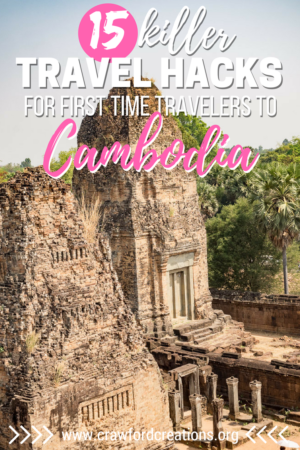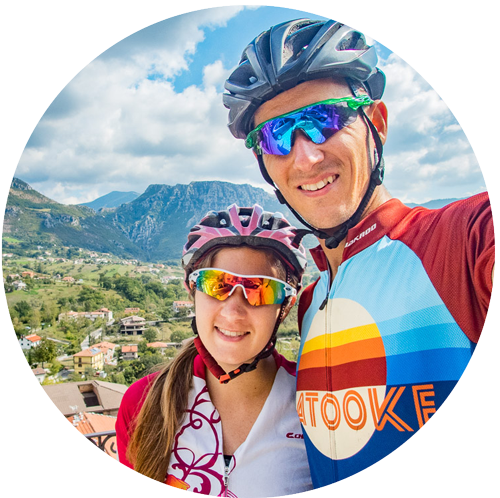15 Killer Travel Hacks For First Time Travelers To Cambodia
***This post may contain affiliate links.***
Traveling to any Asian country, especially if it’s your first time, can be a bit intimidating. Luckily for you, I actually think Cambodia is the least intimidating of all the Asian countries I’ve been to so far.
That being said, as with every country, there’s still some essential information all travelers should know before you go. Here’s everything we learned over our week in Siem Reap that we wish we knew, or advise we knew, but wish we followed, during our time in Cambodia.
We did get a few things right that I had researched before, and I’ll share those as well. I mean, we don’t always fly by the seat of our pants…sometimes. Most people are appalled at how little I plan our trips. Funny thing though, Justin actually thinks I research too much for our trips abroad. I prefer to take the Goldilocks approach.
If you’re reading this post that means you’re probably like me and want to know at least a few things about the place you’ll be going and what to expect. So here are all our best Cambodia travel tips to help you have a hassle-free trip and make positive memories that will last a lifetime.
Read More From Cambodia
- The Ultimate Guide To Visiting The Angkor Wat Temples Without A Tour
- 15 Best Things To Do In Siem Reap, Cambodia
- The Complete Guide To Visiting Cambodia’s Tonle Sap Floating Villages
1. Apply for An E-visa Online

Every international traveler that comes to Cambodia needs a visa to enter the country. While you can get a visa on arrival, you should probably pay the extra $6 and get one online. Here’s why.
First off, lines in Cambodia move painfully slow. We did get an E-visa, but even without having to stand in that line, it still took us almost an hour to get through the 10-15 person line in front of us at Customs/Immigration.
It basically went like this, a new person walks up to the counter with their passport and hands it to the agent at the desk. Said agent leaves the passport on the counter and looks around the room for a minute. He then picks up your passport and proceeds to look around the room some more. After another minute or so he actually looks at the passport in his hand.
Then with the urgency of a sloth getting ready to take a nap, he turns each and every page and inspects all your stamps. After what has been at least 5 minutes now the agent finally scans the passport. He then asks the person to put their hand on the fingerprint scanner.
The fingerprint scanner inevitable has trouble reading said person’s fingerprints so they stand there forever pressing their fingers onto the screen. First, it scans 4 fingers on one of the person’s hands, then the 4 fingers on the other, and then finally their thumbs. Each process taking a minute or two as they wait for the scanner to register their fingerprints.
Occasionally you get a really short person in line who is too short to see the instructions on the scanner that they’ve not so thoughtfully placed at about head level for a 5 ft 3 inch (163 cm) tall person like myself. When I went up I had to stand on my tippy toes just to see the darn thing.
Once the computer is finally done registering you it’s been somewhere between 5 and 10 minutes. You can see how a line of only 10-15 people going through immigration can easily take an hour to get through. Meanwhile, you’re standing in line literally watching your luggage go round and round on the conveyor belt.
The point of me telling you this story is this, cut your losses, pay the extra $6 and avoid standing in line for 2 hours instead of 1 at the airport. Also, when you arrive with an E-visa there’s no need to fill out an arrival or departure card. Not sure why, I guess they already have all your information.
Applying for an E-visa takes literally 5 minutes online. Our visas were approved immediately and we got an email in our inboxes 5 minutes later with our visas. You need to print out 2 copies per person, one to enter Cambodia and one to exit.
You can apply for an E-visa at the official website here.
2. Cambodia Primarily Uses US Dollars As Their Currency

It’s weird, I know, but the primary currency in Cambodia is US Dollars. But it gets weirder, change, as in any amount less than $1, is given in the local currency, Riel. The great thing about this, no coins!
Why the heck does Cambodia, a tiny country on the opposite side of the world from the US, use US Dollars? And how did all this come to be?
The short version is that the Khmer Rouge actually blew up the National Bank in Cambodia and banned money in the 1970s essentially wiping out the Riel. When it was reintroduced in the 1980s nobody trusted it and the currency kept getting more and more inflated and devalued.
When the United Nations came to Cambodia in 1992 they put a ton of US dollars into the economy which then brought in foreign investors who were willing to trade in US dollars. Cambodia quickly adopted the US dollar, which both Cambodians and foreigners trusted way more than Riels, and pegged the Riel at 4000 Riel to 1 US dollar.
Using this 2 currency system Cambodia’s economy has thrived for over 2 decades so, ya know, if it ain’t broke, don’t fix it.
3. Only Take Out Small Amounts of Money From The ATM

Speaking of using US dollars, when you go to the ATM there won’t be an option to choose a currency. You’ll just automatically be given US dollars. As in, if you request $500 from the ATM it will give you 5 $100 bills.
This might not seem like that big of a deal at first until you go to pay for a $2 dollar meal with a $100 bill. Ain’t nobody got change for that. In fact, they can hardly scrape together change for a $20 bill.
We literally got hundred dollar bills out of the ATM our first time and then had to find things to pay for with such a high domination bill that cost enough that they would actually have change for us. If this does happen to you, buying your Angkor Wat tickets is a good way to get change for a $100.
We learned our lesson, and the next time we went to the ATM we only put in $40 amounts at a time so it had no choice but to give us $20 bills. Worked like a charm.
4. Don’t Give Money or Buy Things For Beggars (Child or Adult)

Don’t worry, you won’t get overwhelmed by beggars or anything in Cambodia, at least not where we were in Siem Reap, but chances are good you will come across a few, especially if you go to Chong Kneas, the closest floating village on the Tonle Sap Lake.
Most of the beggars will pull at your heartstrings by asking for money for the kids’ school or to buy food for the kids. Some of them will go so far as to even say they don’t want money, just milk or a meal. Don’t give them anything.
I’m not a cold-hearted person, so let me explain. Here’s why you shouldn’t give money to beggars in Cambodia.
If it’s a child beggar, you shouldn’t give them money, because you’re essentially cheating them out of an education. Here’s how it works, parents send their children to beg, unsuspecting tourists give in to their cute little faces and give them money, the kids go back and give the money to their parents, and then their parents are so thrilled that they keep sending their kids out to the streets to beg instead of sending them to school.
If the kids can’t make money on the streets then their parents will instead send them to school to get an education so that they can provide for the family later in life.
If it’s an adult beggar asking for milk or food, you shouldn’t buy it for them because you’re not actually feeding them or their children. What happens is you buy the milk or food, give it to the person, who then sells it right back to the store you bought it from and pockets the money. Both the beggars and the store owners are in on this scam.
Beggars can actually make so much money this way that they turn down legitimate jobs because they can make more money begging on the streets. How insane is that, from both sides of the spectrum, that you can make more money begging on the street than by actually working. Crazy.
5. Bring or Buy Mosquito Repellent

The mosquitos in Cambodia are like a whole different breed of awful. Especially when you consider the fact that they carry dengue. Trust me, you’ll definitely need to protect yourself.
I think we got especially unlucky because the fan in our bathroom at the hotel had no screen over it so the mosquitoes so every time you took a shower it became a straight up mosquito breeding ground. There were just mosquitoes everywhere, which is unfortunate because we were showering, which means were, ya know, naked. Luckily neither of us got mosquito bites in too embarrassing of places but still, it was not fun.
Regardless of the mosquitoes in our room, when we went out at dusk and in the early mornings there were also a bunch of mosquitoes just outside buzzing around. There are one of two ways you can handle the mosquitoes.
One, you can simply just wear long pants and long sleeves. The problem with that is that if you haven’t heard Cambodia is a tropical country, which means it close to the equator, which means, it’s really freaking hot there! Not too many people can handle wearing long pants and long sleeves in Cambodia’s hot, humid climate. When we were there in February the high was 100 degrees F or 38 degrees C. And don’t even get me started on the sun, it’s intensely hot.
The second method is the one we employed which was to buy bug spray, carry it with us, and use it liberally all day every day. Unfortunately, we were sweating so much that a lot of came off and we still got bug bites. But we certainly got way less than we would have had we not done anything. I don’t even want to imagine how many bites I would’ve been covered in without bug spray.
You can find bug spray, and pretty much any other toiletry necessities you might need at the few larger supermarkets in Cambodia. We tried first looking in the more conveniently located mom and pop shops and nothing.
6. Tuk Tuks or Renting Scooters/Bicycles Are Your Main Forms of Transportation

Basically, unless you book your entire trip as part of a large tour group that rents buses, don’t expect any A/C during your transportation. Tuk Tuks are where it’s at for travelers that don’t have their own form of transportation. Locals seemed to prefer scooters or bicycles, which you can rent at many different shops in Siem Reap and Phnom Penh.
7. Don’t Accept Any Ripped Bills

While the US dollar is Cambodia’s primary currency they’re real picky about the condition of your dollars. If it’s not pristine, or close to it, there’s a good chance that most places won’t accept your money. We got stuck with a fifty dollar bill that was apparently sub-par so nobody would take it.
Luckily we’re American so being stuck with some US currency is not a big deal, but it’s still super annoying. To avoid getting yourself in this predicament, have the same standards for the change you receive as the Cambodian merchants do. If someone tries to give you a really old bill, a ripped bill, or one with any sort of writing on it, don’t accept it. Make them find you another bill.
The funny thing is they could care less what the Riel bills look like. I guess it’s because they’re not worth much anyway.
8. Outlets Are 2 Pronged European Style Plugs In Most Places

Unless you’re European, make sure to bring an adapter with you to Cambodia to charge your electronics. You’ll need a two-pronged European plug to fit in the outlets. We’ve got one of these handy dandy multi-country plug adapters we (try to remember to) bring everywhere with us so we’re always prepared no matter the country.
9. Don’t Drink The Tap Water

As with most Asian countries, and pretty much all developing countries, the tap water is not safe for human consumption. Drinking unsafe water is not something you want to test or play around with. We’ve had the Montezuma’s revenge sickness, it’s not fun. Especially not when you’re on vacation.
We bought bottled water during our time in Cambodia for pretty cheap. The only time you’ll get gyped for water is outside of Angkor Wat temple where they’ll charge you $6 for a bottle of water.
You can also use one of these awesome Lifestraw bottles that filter the tap water as you drink it and make bacteria contaminated water safe to drink. We have Lifestraws, but for some reason can never remember to pack them. We really need to kick that bad habit.
10. Bring or Buy Sun Protection

The sun doesn’t mess around in Cambodia. I swear it’s like 50 feet away and will burn you to a crisp in under an hour. If you’re a tighty whitey like me, do yourself a favor and bring or buy sunscreen, apply it liberally, and maybe wear a hat while you’re at it. Something I also forgot to bring.
11. Visit Temples in the Early Morning or Late Afternoon To Avoid the Crowds & Heat

Speaking of the sun, Cambodia is hot! Like you can seriously get heat stroke in February hot. To keep yourself feeling fresh and staying out of the hospital, do most of your sightseeing in the early morning and late afternoon/evening.
You’ll feel better, have to buy less $6 water bottles, and just overall have more fun when you’re energy’s not being drained from the heat. Plus you can take advantage of all that golden hour light in your travel photos.
Oh and not to mention you’ll avoid a lot of the crowds this way as well, as most people use the middle of the day as their time to be out and about, especially tours, which there are a lot of in Siem Reap.
12. Angkor Archaeological Park is FREE To Visit Every Day After 5:30 pm

You read that right, the Angkor Wat temples are free to visit every single day after 5:30 pm. This means you can watch the sunset in the park every day without ever buying a ticket.
The downside is that only two of the temples are open after 5:30, Pre Rup, and Phnom Bakheng. But heck watching the sunset from outside of a temple is often just as pretty! There are also a lot of lakes and moats inside the parks that make for great sunset reflections.
13. Bargain for Goods At the Old Market

If you shop at any outdoor market in Cambodia you’re expected to bargain. I mean, if you don’t the sellers would be delighted, but for your sake, you should.
As a tourist, the starting price offered by the shop owners is automatically higher than the local price. Keep this in mind if you start to feel bad about “nickel and diming” the shopkeepers. They won’t sell a product for a loss, so don’t be afraid to offer a lower price.
Also, all of the shops basically sell the same stuff, so if one person is not open to bargaining, just move on to a different stall. The shops at the entrance or in the front are often less amenable to bargaining and will charge higher prices than the shops in the middle or back of the market. This is simply because their convenient location means they get more business and therefore don’t have to worry as much about getting every sale.
14. Bring Conservative Clothing To Visit Temples

You won’t be allowed into any of the Angkor Wat temples if you’re not wearing appropriate clothing. The dress code is very prominently stated at the ticket office, but basically, you must cover your knees and shoulders before entering any of the temples.
You can get into the park in shorts and a tank top, but the guards at each individual temple entrance won’t let you in unless your shoulders and knees are covered.
We can thank some very disrespectful tourists for this rule, who, in 2016 decided it would be a great idea to take nude photos at the temples. Why they thought that would be a good idea just beats the heck out of me.
Luckily, it’s pretty easy to dress appropriately. Guys just need to have shorts that go down to your knee caps (they can’t stop above your knees) and wear a regular old t-shirt. Girls can wear a t-shirt and long skirt, a long short-sleeved dress, bring a light button up blouse to cover their shoulders, or simply wear shorts and a t-shirt and buy one of the awesome “Cambodia skirts” they sell in the markets that are basically just easy tie sarongs.
The Cambodia skirts are cool because you can easily take them on and off when you go in and out of the temples. You can always just buy your fill of super lightweight, super cheap, super cute elephant pants/skirts/tops to act as your appropriate temple clothing as well. I paid $4 for my long Cambodian skirt. It’s super cute and I love it.
15. Avoid White Clothes

This might seem like a weird tip, but the entire country of Cambodia is covered in red dirt, that’s probably red clay during the wet season. Point being, it’s bright red, and it gets on everything. Our entire bodies were covered from head to toe in red dust every day in Siem Reap.
Whenever I would come back to the hotel I would rinse my face off with water thinking I got all the dirt off only to dry it with a white towel that was then no longer white. My sandals got so caked in red dirt that I literally had to scrub them clean with soap and water when we got home.
I was lucky that my preemptive washing in our hotel sink prevented any of the dirt stains from ruining my clothes, and everything came out of the washing machine at home stain free.
WANT TO TRAVEL CHEAPER & EASIER?
Subscribe to follow our blog and be the first to read our new posts!
Success! Happy dance optional :) P.S. check your inbox for goodies!
Like this post? Share the love and pin it on Pinterest!

*** This post may contain affiliate links. By purchasing a product or service through these links you are helping to support this blog at no extra cost to you! We only recommend products we personally use and love! ***




 Hey, we're Cara and Justin, the adventure travel loving couple behind Crawford Creations. We're here to help you travel the world independently, save money on your travels, and discover off the beaten path destinations along the way. Click the About tab to find out more!
Hey, we're Cara and Justin, the adventure travel loving couple behind Crawford Creations. We're here to help you travel the world independently, save money on your travels, and discover off the beaten path destinations along the way. Click the About tab to find out more!



Great need to know travel information for Cambodia!